Any experts on Peruvian food?
Any experts on Peruvian food?
-
-
-
-
-
Any experts on Peruvian food?
-
Post #1 - April 5th, 2006, 9:58 pmI'll be spending about 5 nights in Cuzco at the end of April and will have some opportunities to venture out for dinner. I'm really unfamiliar with Peruvian cuisine and South American cooking in general. The only Peruvian specialties I am even vaguely aware of are ceviche and guinea pig (which I understand is typically eaten for special occasions - although I imagine one can find it in a restaurant for curious tourists).
Figured it might be a long shot but has anyone been to Cuzco or Peru in general who can suggest some traditional foods to try? Anything that is a must-eat-or-have-your-passport-revoked dish? Restaurants recs would be amazing but even just having an idea of what to look out for would be helpful.
-
-
Post #2 - April 5th, 2006, 10:54 pmHi,
If you are going to Cuzco, then are you going to visit Machupichu as well?
Maria Kijac, a friend of mine, wrote the book South American Table, which would be a good primer on what foods to look for.
Regards,Cathy2
"You'll be remembered long after you're dead if you make good gravy, mashed potatoes and biscuits." -- Nathalie Dupree
Facebook, Twitter, Greater Midwest Foodways, Road Food 2012: Podcast
-
-
Post #3 - April 6th, 2006, 6:37 amTry Ay Ay picante. It's on Elston and serves really good anticuchos: grilled beef hearts and try Lomo Saltado. It's a beef dish with a tomato, onion sauce and french fries on top. Be prepared to eat a great deal of starch. It is not unheard of to have potatoes on top of rice.
Ay Ay Picante
4569 N. Elston Ave., Chicago
-
-
Post #4 - April 6th, 2006, 7:47 amCathy2 wrote:
If you are going to Cuzco, then are you going to visit Machupichu as well?
Yes - the other half of our trip will be spent hiking the Inca trail and camping out
-
-
Post #5 - August 1st, 2008, 4:56 pmResurrecting this thread from 2 years ago:
I will be 9 days in Peru later this month. 3 days, 4 nights in Cuzco and two days and nights in Lima (in addition to the Machu Pichu hike).
I know this is an increasingly popular trip. Has anyone been? I certainly will try to experience ceviche in the land of its provenance (in Lima, not inland) as well as parillada and cuy.
Does anyone have other recommendations of local food to try or, even better yet, neighborhoods or even specific places not to miss?
-
-
Post #6 - August 2nd, 2008, 10:40 amI'm not an expert, but I have been to Peru on a couple of occasions and am always amazed by the wonderful food. I was fortunate to be traveling with locals who did most of the ordering, but here are some of my favorites.
While in Lima seafood is wonderful, particularly the ceviche, I would recommend going to a cevicheria. You can also get great anticuchos in the Barranco neighborhood. I also really enjoyed the Chifa, Peruvian Chinese food.
If you have the chance, check out a Wong's grocery store in Lima, it's a high end local grocery chain that has wonderful sweets and produce.
In addition, some of my favorite dishes are:
Sopa a la Criolla- beef soup with pasta and egg, it's a one bowl meal. In the Cusco region they do not traditionally put the egg in the soup, but you may be able to request it.
Aji de Gallina- chicken in a creamy sauce with aji
arroz con pollo - Peruvian's use cilantro in their arroz, so it is a green rice dish
Causa - which can be made with many ingredients, but is a casserole most often with mashed potatoes and tuna and is generally served cold
Tamales- the ones I had in Peru were rather sweet and moist, different from Mexican tamales
Papa Rellena - potatoes stuffed with beef, absolutely delicious
Papa a la Huancaina - the huancaina sauce is very common in Peru, it's a mild creamy sauce that always reminded me of peanuts, but I don't think it has any peanuts in it.
Lomo Saltado- beef strips with vegetables, generally served with rice and french fries or potatoes
To Drink:
Chicha Morada- purple corn drink that is very refreshing (it's the non fermented version of Chicha, a common alcoholic beverage)
Mate de coca- coca tea, very good for helping with altitude adjustment when arriving in Cusco
Pisco Sour- delicious drink made with Peruvian brandy
-
-
Post #7 - August 10th, 2008, 5:28 pmI head a small group at my church called "International Dining Small Group". It's hard to believe my wife has her Master's in Speech Communication isn't it? Some day we may come up with a more creative name.
Last month, I took the group to a Peruvian restaurant. In researching Peruvian cuisine, I discovered the Wikipedia entry and was fascinated by it. The food of Peru has had much more international influence that I would have ever guessed. The various regional differences were also very interesting. When you return please let us know what you ate, where you ate, what you learned about Peruvian cuisine, etc.
Ceviche was well known to me and, i remembered that my daughter ordered what turned out to be a Peruvian version of chicken fried rice the first time our family ate at a Peruvian restaurant - appropriately named Machu Picchu.
-
-
Post #8 - January 4th, 2009, 5:53 pmThis seems as good a place as any to finally report on my Peruvian food adventures. My trip occurred in the middle of August, which is the dry, more wintry season. I spent a week in the Andes (3 days in Cuzco, 4 days on the Inca trail) and another day and a half in Lima on the coast before coming home.
My first post will cover Andean markets I visited. Most of the shots come from the central covered market in Cuzco.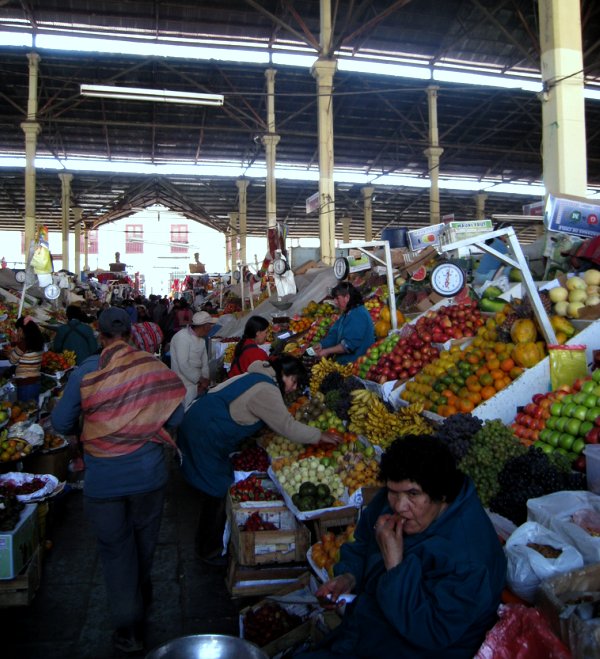
Cuzco, a city of 350,000, manages to have a year-round public market. C'mon Chicago!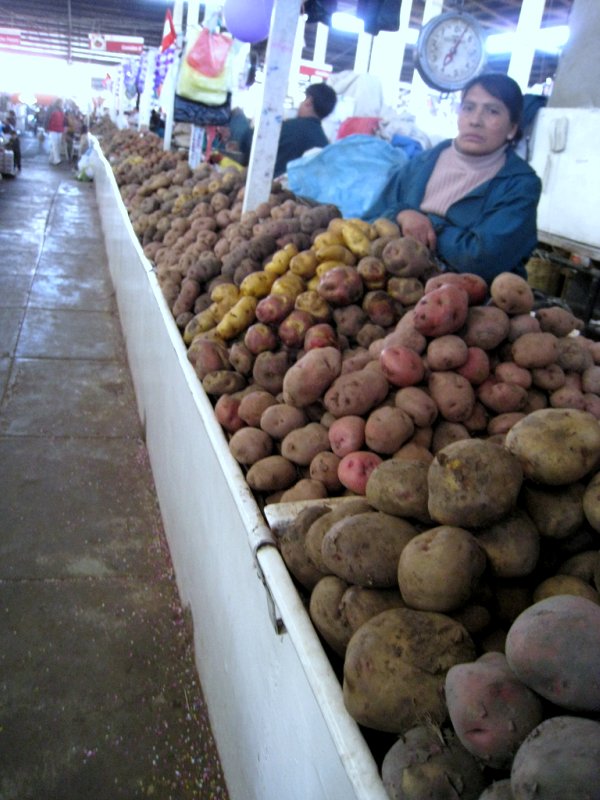
Here was the potato aisle. Peru is known for the diversity of potatoes, with hundreds (perhaps thousands) of different varieties grown around the country. I ran into many types of potatoes throughout the trip, some looking familiar and some in new shapes and sizes.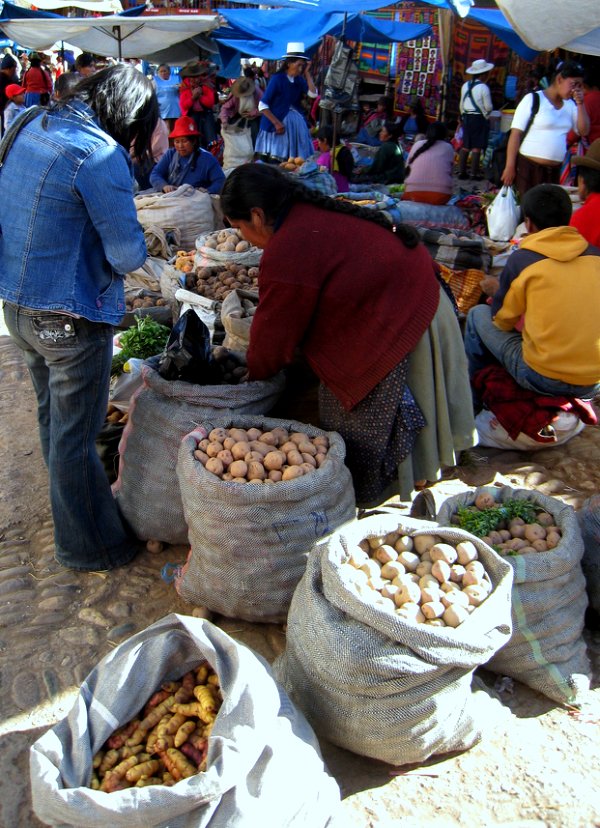
More potatoes.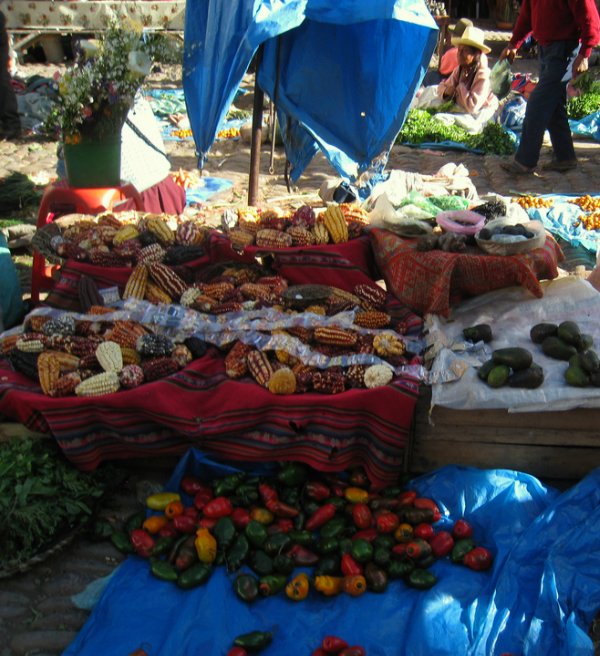
I also ran into new varieties of corn. Mainly this meant short cobs and very large kernels (more on this later).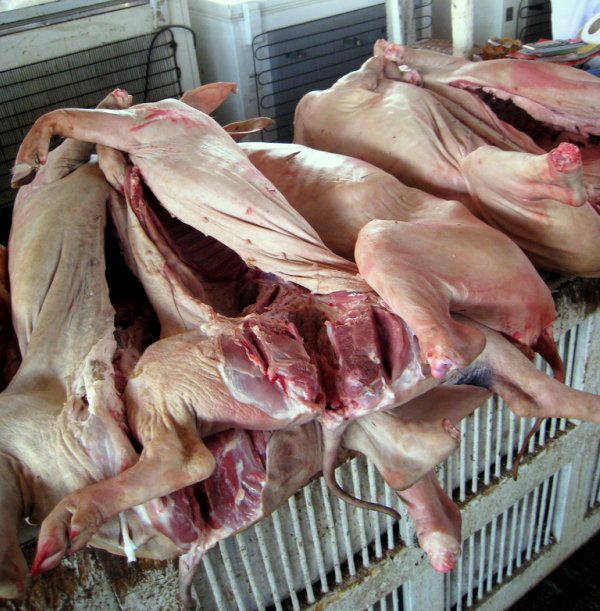
Pigs were available...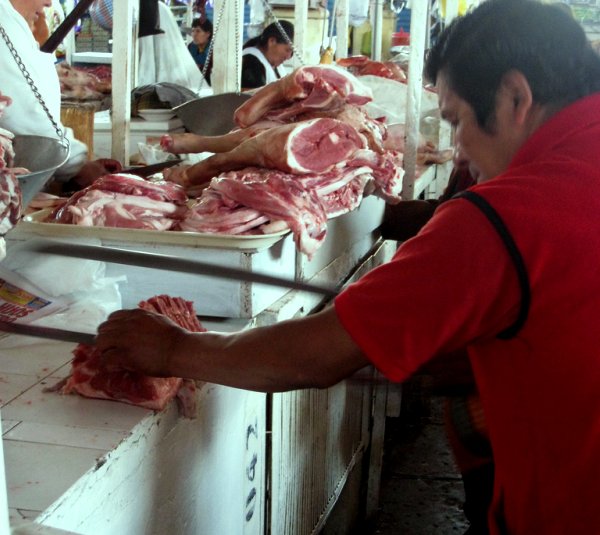
...and cut to size...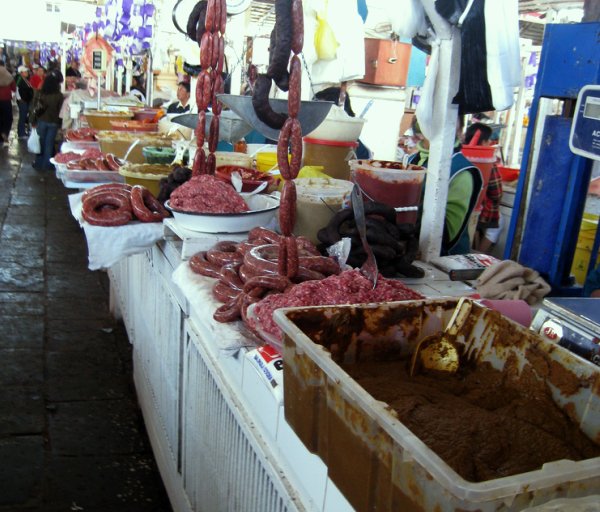
...or turned into sausage.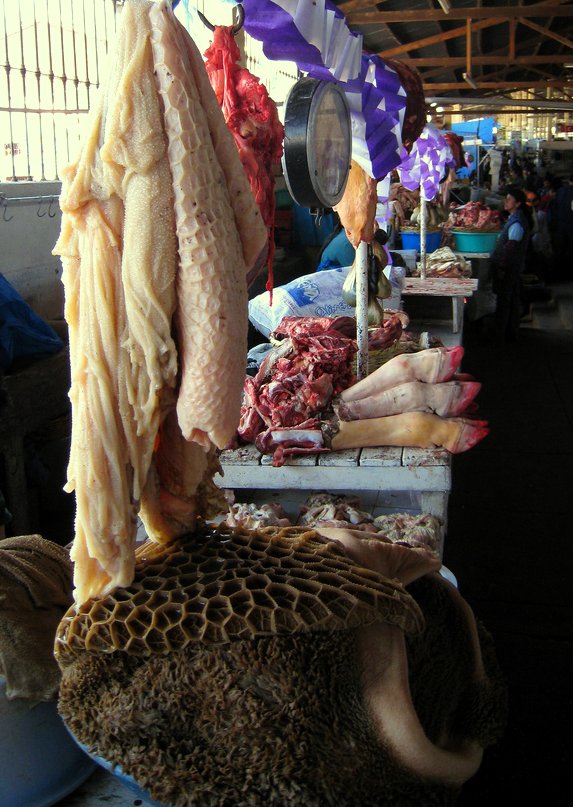
One could comb...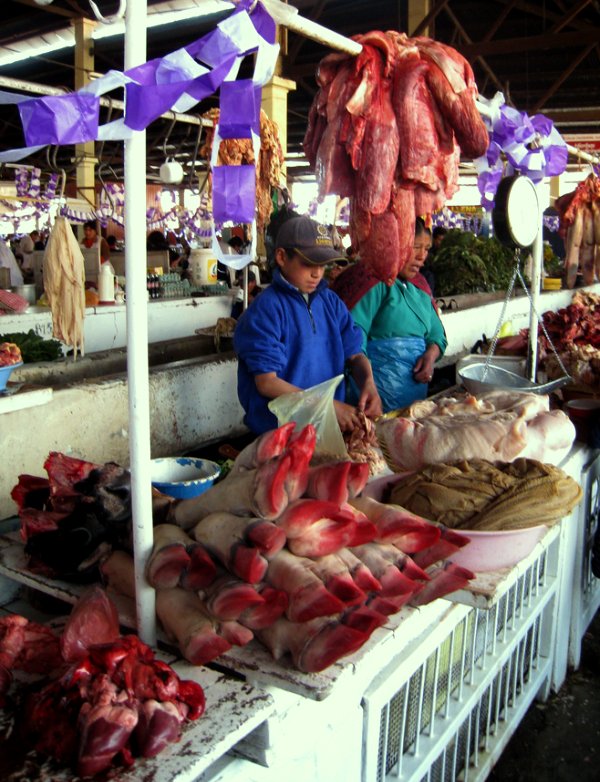
...through offal and other spare parts.
Didn't see these at the Evanston Farmer's Market.
-
-
Post #9 - January 4th, 2009, 6:34 pmNow, on to things I actually ate. I was not able to be as adventurous an eater as I planned on this trip. I didn't ever sit down and feel like ordering cuy, so that is a local delicacy that went unsampled. But I still got to try most of what I wanted.
The breakfasts I enjoyed at our hostal (really, like a hotel more than a hostel) were simple but a fine way to fortify for the day. They baked a bread each day that reminded me of pita, but was thicker and doughier. A fresh basket of this was provided along with jam and (sadly) margarine. I started each day with mate do coca in an effort to avoid altitude sickness. I never experienced any headaches or nausea, but I wouldn't ascribe this to my daily dose (or two) of mate de coca. Nor did I feel any of the get-up-and-go energy made famous by the other well-known product of this plant. The tea was bitter, but not overly so. Generally the eating area was chilly in the mornings so the tea helped me to warm up. Two women staffed the kitchen each morning and offered to scrambled or fry eggs to our liking. Lastly, we got a fruit bowl of kiwis, strawberries, melon, mango and other local products with or without yogurt. This hostal was really a budget establishment so a hot breakfast of any kind was appreciated - but this was actually good and cooked to order! It helped start each day off on the right note.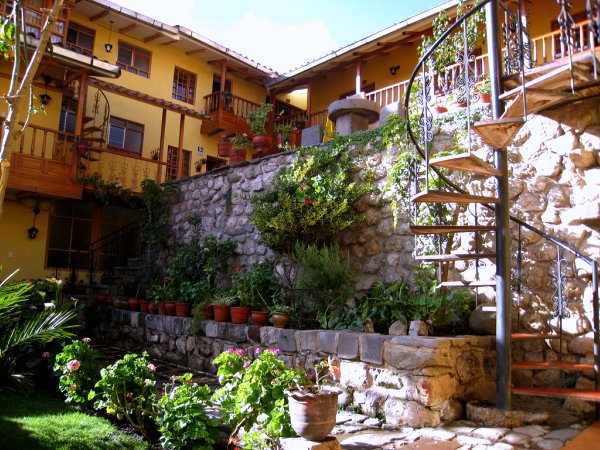
The Amaru Hostal. I saw hummingbirds feeding from the flowers in the courtyard (darn things move too fast for a picture). Yes this was not the warm season, and yes we are at 11000 feet elevation, but the whole town basked in the sunshine and temperatures got into the 70's during they day. In a nearby town, I saw what looked like a palm tree. I am told that in the Andes microclimates are everywhere.
I was also very pleased with the quality of food we received from our touring company (Peru Treks) while hiking the Inca Trail. The majority of our party was made up of porters and cooks, so there was certainly some serious attention being paid to the food. Incidentally, all the following photographs on a red or yellow tablecloth were taken on the trail. Yes, we sat down to meals at real tables with metal plates and silverware on tablecloths - an unexpected bonus. Meals numbered 4 or more a day, including at least one snack. The 2nd day featured a 1000 meter change in elevation (up, that is), so replenishing calories was important.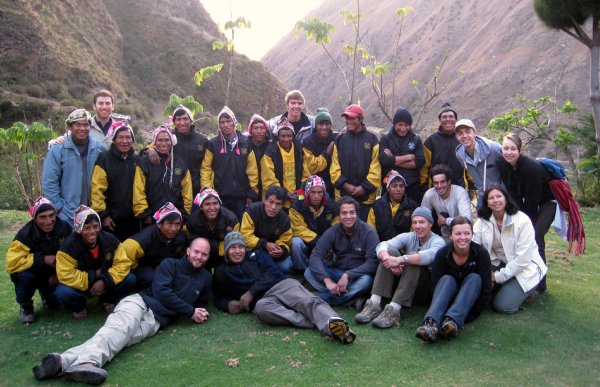
The hiking party. The porters/cooks were amazing. Not only did they cook the food, but they carried it all, along with the tents and all the cooking equipment - and did it a lot faster than the gringos, typically arriving to camp at least an hour ahead of us. This too, was not cured by coca tea.
As I mentioned, I had a fair number of soups on the trip: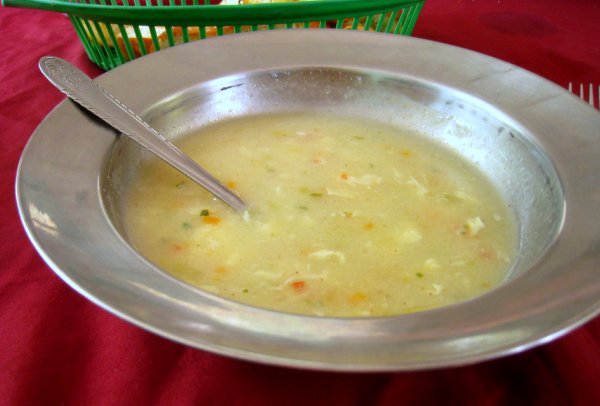
I believe this was a thinnish chowder with some egg and diced vegetables. There was a spicy powder provided to sprinkle over most of the soups.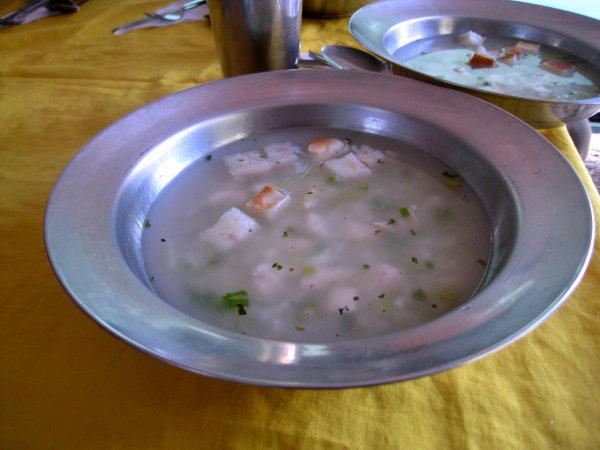
This was more of a chicken soup with some croutons or pieces of bread (I think).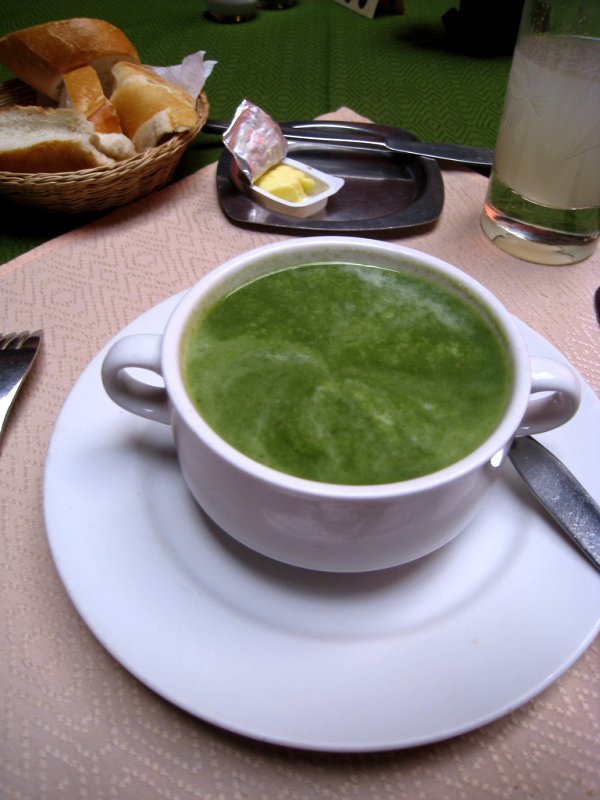
More soup, this time cream of asparagus at a convent in Lima that also runs a French restaurant. The bread was also very good.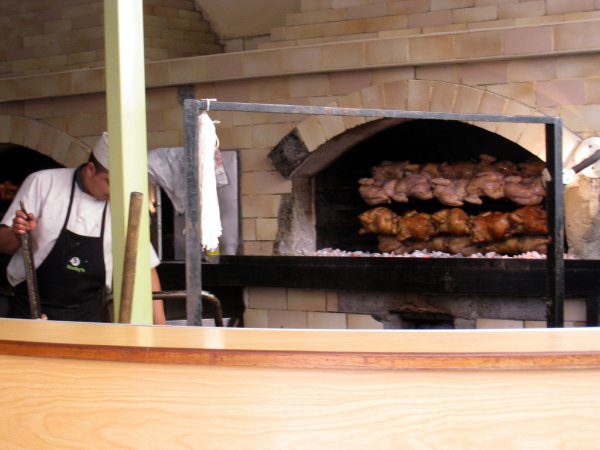
Of course, there was a fair amount of roasted chicken. I do not recall stopping into one of these pollerias.
Peru is known for llamas and alpacas. Both are domesticated versions of the guanaco which is another four-legged Andean dweller. You might buy an Alpaca hat or sweater, but did you know they also make fine brochettes?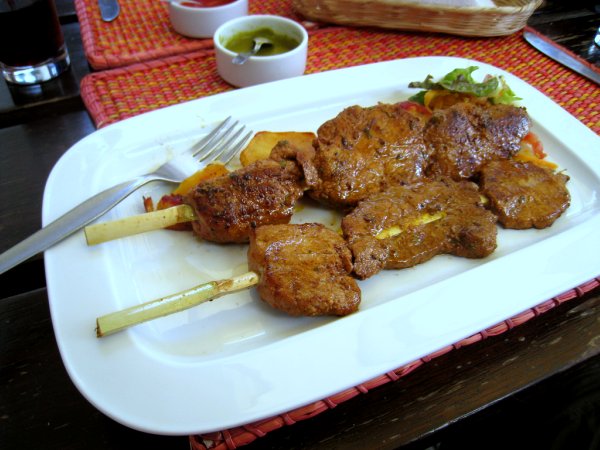
Alpaca brochettes. The taste was a little bit gamier than beef, but not to excess. These were spiced and grilled. Along with the lima bean, corn and cheese salad they made for a nice lunch.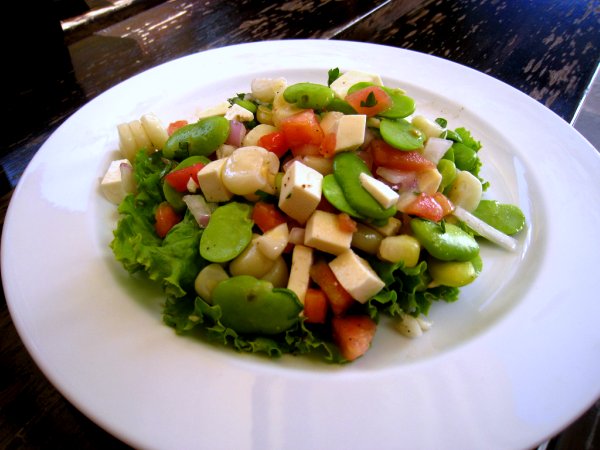
Salad, with previously mentioned large kernels of corn.
This salad featured avocados, chopped nuts and a healthy sprinkling of cheese. Like I said, we needed calories.
Here was one of the aforementioned snacks consisting of some biscuits, margarine, jam, ham sandwiches, hot cocoa, and some freshly popped popcorn.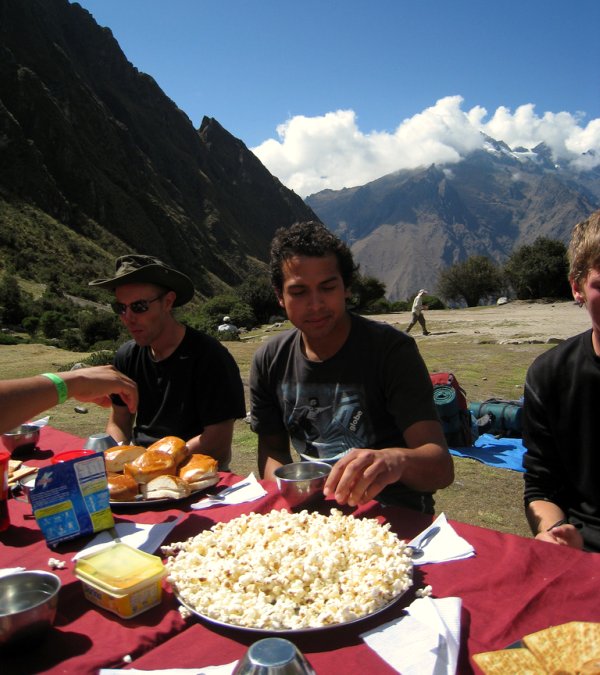
Possibly the most picturesque place on Earth to eat popcorn.
Some offerings were more familiar. This chile relleno had a different sort of filling than I was used to - more like a picadillo.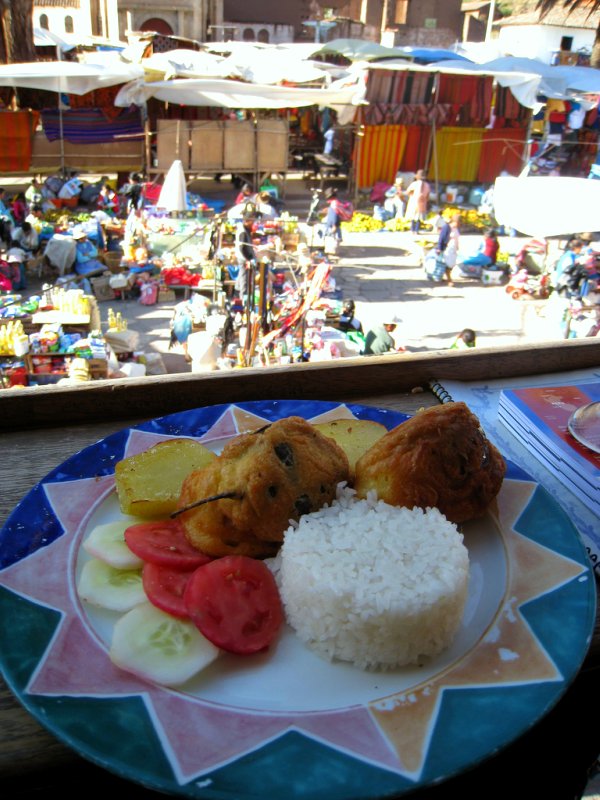
I also ate a fair amount of trout while in the mountains. I didn't expect fish would be abundant in this region, but trout was an option most places. I particularly enjoyed the trucha al ajo (sauteed in a garlic butter sauce). We got trucha frito on the trail which was also good.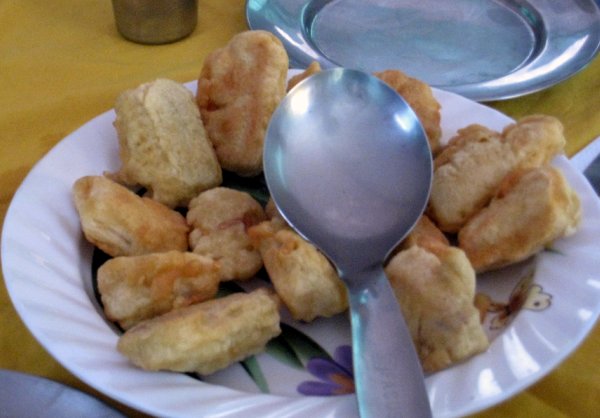
Fried trout.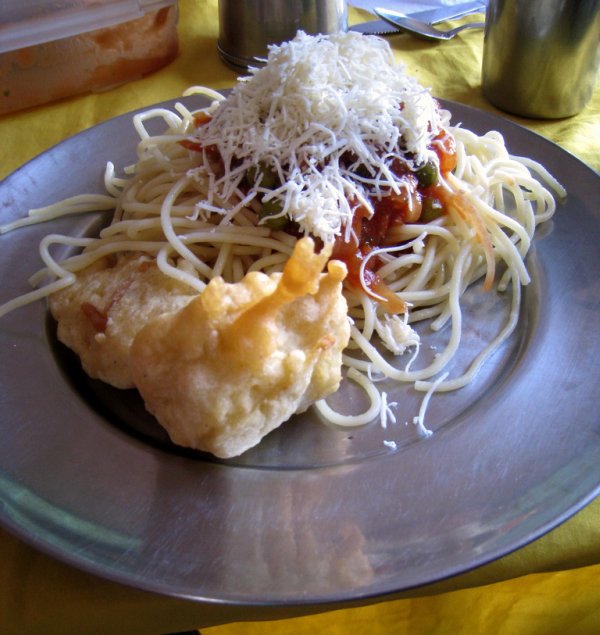
With spaghetti
I also sampled a fair number of drinks. Many tropical fruits that grow well in Peru given its climate. Fresh pineapples, mangoes, passion fruit and others were fodder for many drinks. Smoothies were available in most cafes. One drink that is particular to Peru is chicha morada, made from blue corn. I see this was offered at Cafe Salamera. I hadn't heard of it before but took a fancy to its deep color and sweetness.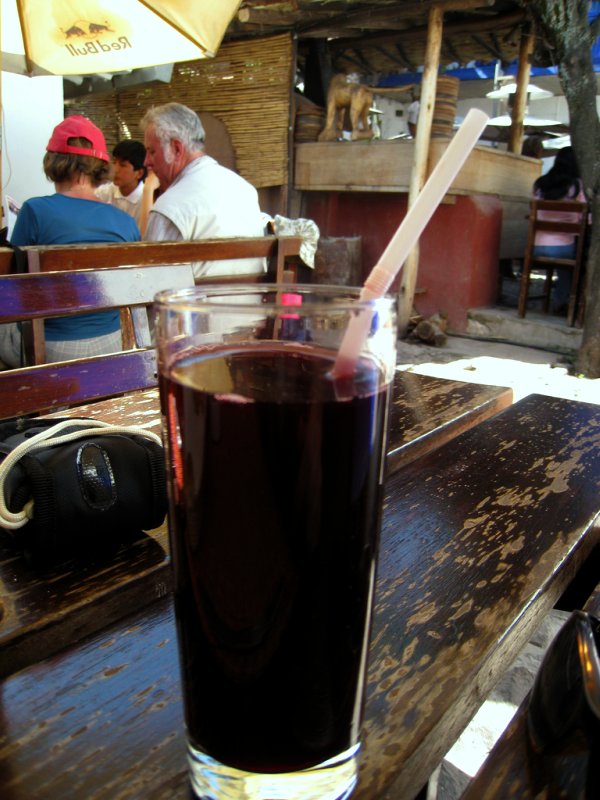
Chicha Morada.
Chicha morada was the main flavorant in my favorite dessert from the trip. It flavored a gelatin and was served with rice pudding.
This was warm, multi-textured and delicious.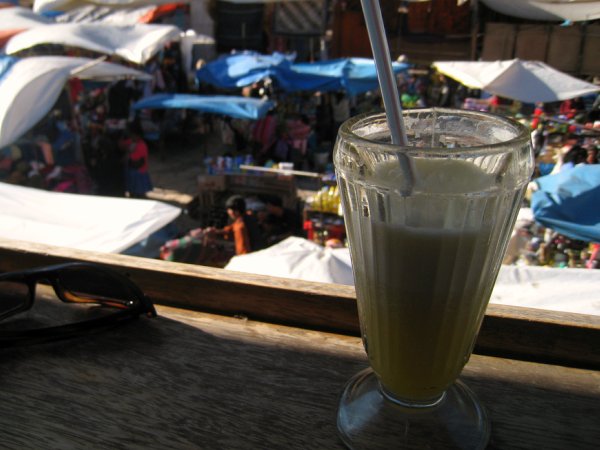
Pineapple juice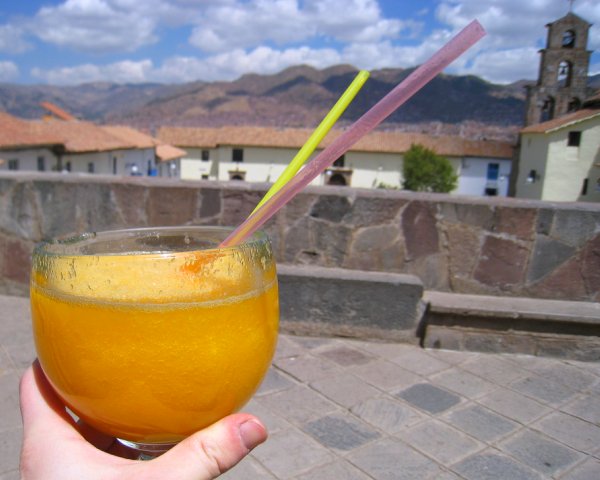
Mango smoothie
Other memorable eats included lomo saltado, the traditional beef stir-fry, which I had a few times. I also tried the papa rellena, potatoes filled with ground beef and deep-fried. Papa al a huancaina - potatoes covered with a spicy cheese sauce - as a favorite of my traveling companion. He also ordered one of the better bites of the trip - a quinoa pancake. Essentially cooked quinoa was mixed with thinly diced vegetables, mixed with a loose batter and then sauteed until golden on both sides. French fries are also served with many dishes (as a base for lomo saltado, for one) and were generally thick and cooked softer than I would usually order.
My last two nights back in Lima, I indulged in some ceviche and anticuchos (shish-kabobs). I specifically ordered the beef heart and found it steak-flavored, but a little chewy for my tastes. Pisco sours are a popular local cocktail (pisco is a brandy). It could have been the end of a week of travels, but it only took one of these to knock me into a happy-fun place.
I was primarily on this trip to see Machu Picchu and hike the Inca trail. From that point of view, the trip was an unadulterated success. I was somewhat surprised to eat as well as I did though. I knew little about Peruvian cuisine before I went (notice my post above), but I remain ever more intrigued after sampling it there. The food reflects the multifacted nature of the country: derived from mountainous, coastal and tropical regions, with a mixture of indigenous cuisine along with Spanish ingredients and influence. In more modern times, some aspects of Chinese and Japanese cooking has crossed over as well. And the country has been home to centuries of carefully cultivated vegetable biodiversity, which provides a wealth of ingredients to chose from.
Peruvian food is a great deal more than just roasted chicken and a spicy sauce, as delicious as that can be. I have not tried any of Chicago's Peruvian restaurants since returning, but finally putting this post together reminds me that I am anxious to see what they have to offer. Maybe an LTH dinner at Pollo Salvaje, Taste of Peru or D'Candela is in order sometime soon.
Edited to improve some sentences that possibly bothered only me.Last edited by gastro gnome on January 4th, 2009, 10:02 pm, edited 1 time in total.
-
-
Post #10 - January 4th, 2009, 7:38 pmWow, fantastic pictures. Thanks for posting them, commentary included.Watch Sky Full of Bacon, the Chicago food HD podcast!
New episode: Soil, Corn, Cows and Cheese
Watch the Reader's James Beard Award-winning Key Ingredient here.
-
-
Post #11 - January 5th, 2009, 10:16 pmThanks for the beautiful images, gastro gnome! I just happened to see Bourdain's trip to Peru earlier this evening-are you sure you weren't there working as his still photographer? His shots have nothing on yours.
I especially like your shot captioned, "One could comb." Great lighting, composition, depth of field. Just a terrific shot. What is the darker comb below the tripe? It looks like a giant morel.Man : I can't understand how a poet like you can eat that stuff.
T. S. Eliot: Ah, but you're not a poet.
-
-
Post #12 - January 6th, 2009, 9:58 amGreat photos! I loved the shots with the mountains in the background and loved the market scenes. Thanks for sharing!
-
-
Post #13 - January 6th, 2009, 10:55 pmThanks for all the kind words. It was about time I got to posting all this (can you tell I was procrastinating for 4 months)?Josephine wrote:I especially like your shot captioned, "One could comb." Great lighting, composition, depth of field. Just a terrific shot. What is the darker comb below the tripe? It looks like a giant morel.
Josephine, I honestly couldn't tell you what innard that was. But it was eviscerated, stacked and plain for all to see. I couldn't leave without documenting the mystery.
-
-
Post #14 - January 7th, 2009, 9:13 amI was curious, myself, Josephine (it is indeed a beautiful shot) and so I did some research on tripe and found this link. So, the bottom would appear to be the "true stomach" or 4th stomach, the abomasum - which isn't eaten too often, but can be used for rennet. The one covering it is obviously honeycomb tripe, and the hanging ones must be book tripe and honeycomb tripe that have been processed - it's also possible (just a guess from size, no personal experience with unprocessed animal guts) that the greener ones are cow and the whiter ones are sheep or goat. If you are a fan of Dirty Jobs, you will know that green tripe is the new black when it comes to dog food.
Thanks so much for the photo travelogue, gastro gnome! Keep up the good work!
-
-
Post #15 - January 7th, 2009, 7:40 pmMhays wrote:I was curious, myself, Josephine (it is indeed a beautiful shot) and so I did some research on tripe and found this link. So, the bottom would appear to be the "true stomach" or 4th stomach, the abomasum - which isn't eaten too often, but can be used for rennet. The one covering it is obviously honeycomb tripe, and the hanging ones must be book tripe and honeycomb tripe that have been processed - it's also possible (just a guess from size, no personal experience with unprocessed animal guts) that the greener ones are cow and the whiter ones are sheep or goat. If you are a fan of Dirty Jobs, you will know that green tripe is the new black when it comes to dog food.
Thanks, Mhays! It looks as though the world is in no danger of running out of rennet any time soon. If we could only arrange to power our cars with it. . .Man : I can't understand how a poet like you can eat that stuff.
T. S. Eliot: Ah, but you're not a poet.
-
-
Post #16 - January 8th, 2009, 11:15 pmJosephine wrote:I especially like your shot captioned, "One could comb." Great lighting, composition, depth of field. Just a terrific shot. What is the darker comb below the tripe? It looks like a giant morel.Mhays wrote:I was curious, myself, Josephine (it is indeed a beautiful shot) and so I did some research on tripe and found this link. So, the bottom would appear to be the "true stomach" or 4th stomach, the abomasum - which isn't eaten too often, but can be used for rennet.
I'm usually not one to get into arguments about ruminant digestive anatomy but isn't that an inside-out rumen? The rumen, the first and largest of the four stomach chambers, is distinguished by abundant villi—projections that increase surface area and thus facilitate absorption. Clearly the honeycomb-like section is the reticulum, the second chamber, responsible for regurgitation. I'm guessing the lighter-colored pieces hanging on the left are the omasum (third chamber; book tripe) and abomasum (fourth) from a suckling animal (no chlorophyll or other plant pigments to stain the tissue).
For a swell picture of a dissected cow stomach see here (more details here; scroll down for close-ups and annotation). For culinary uses of the abomasum and other tripes, see this classic post by RST.
Thanks for the fine photos, gastro gnome. I always enjoy pictures of markets in other lands.
-
-
Post #17 - January 11th, 2009, 4:56 pmLet me add to the accolades - this is the kind of post that just makes the site for me. Thank you for transporting us to the Inca Trail and markets of Cuzco in this snowed-in January.
Did you by chance visit the Coricancha / Church of Santo Domingo in central Cuzco? What did you think about the preservation of the site, and the available English-language text/guides? I wrote several papers on the site without ever having seen it firsthand.
-
-
Post #18 - January 11th, 2009, 5:17 pmYour guess is probably better than mine, Rene! I was going by the lip-like structure you see both in my linked post on the L and on the bottom right in gastro gnome's photo, but the hairiness is distinctive.
-
-
Post #19 - January 13th, 2009, 10:47 pmTransporting myself back was part of the fun of finally posting all this info. I am happy to share.
I did in fact go to Coricancha (Qorikancha, and any other number of Quechan spellings) - actually the same day I went to the market.
Qorikancha is, as you say, the site of an Incan ruin in Cuzco on top of which was built a Catholic church. The interior featured some Incan walls and stonework (for display, not structurally necessary), but most of the building was remade in a churchly fashion.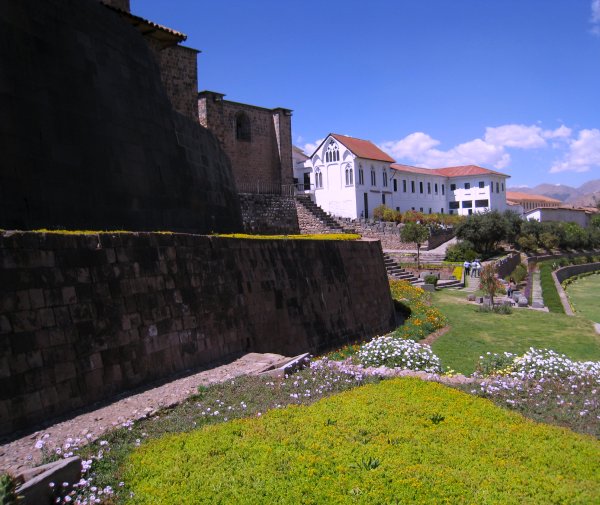
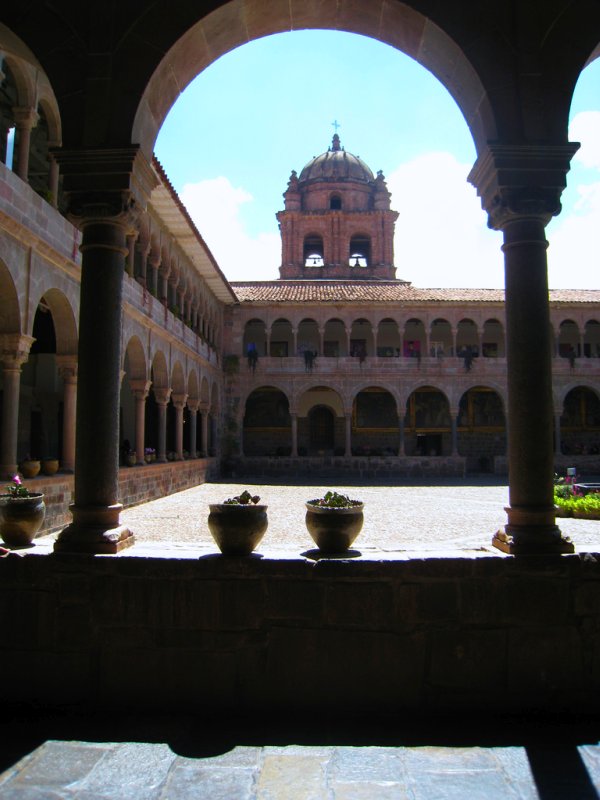
I remember that the on-site museum materials were quite good and I did a fair amount of consulting with my guidebook as well. An unexpected joy was the garden you see in the first picture. A number of people were were sunning themselves and enjoying the high noon. An even more surprising delight was the exhibition space that they maintain on the 2nd floor along with an artist's workshop (I saw looms and such). There were a number of sculptures, paintings and other eye-catchers, all on top of a 300 year old church on top of a 500 year old ruin (these are rough estimates).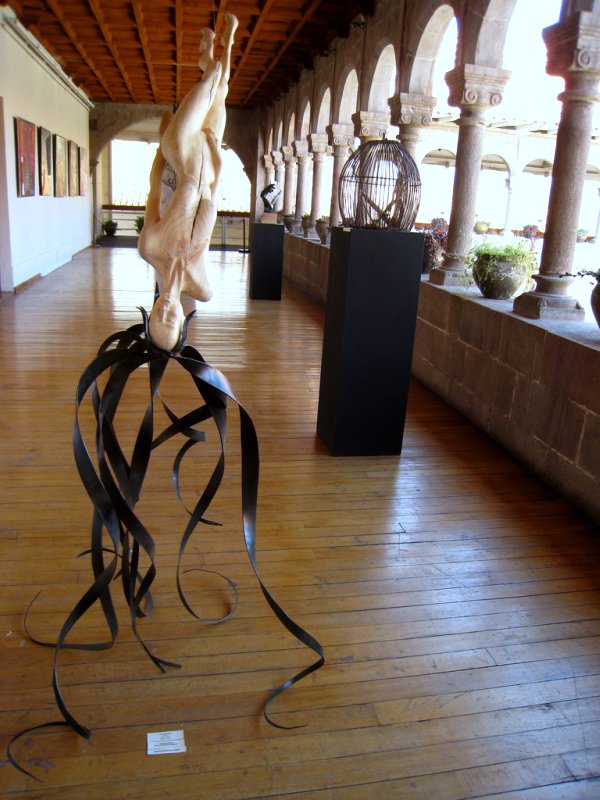
This is definitely a recommended spot in Cuzco.
-
-
Post #20 - January 14th, 2009, 10:51 amThank you for the current inside info, culinary and art-historical alike!
-
-
Post #21 - August 23rd, 2013, 2:57 pm
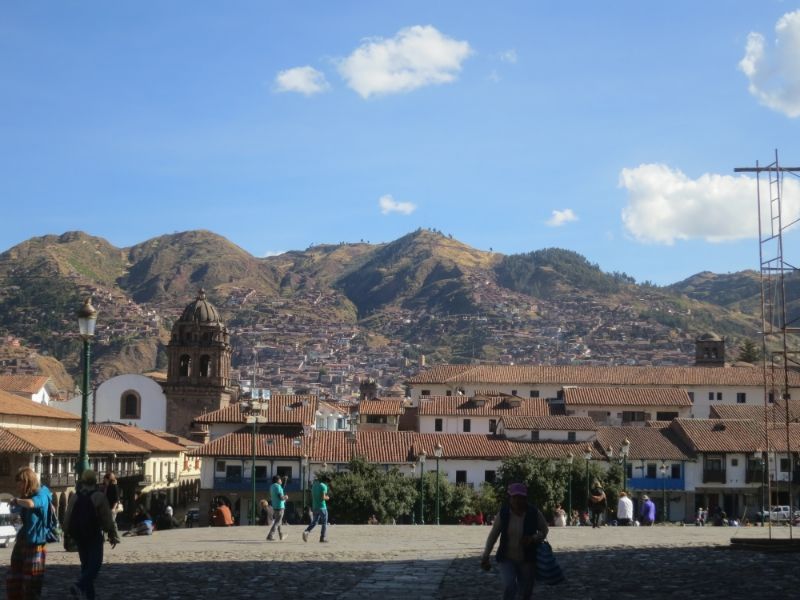
Cusco was the capital of the Inca empire and maintains a strong cultural link to its Inca roots. The modern descendants of Inca culture are called Quechuas and their culture and language were present throughout Cusco and the rest of the region. It was interesting to contrast Cusco with Lima since Lima strongly identifies with Spanish colonial culture whereas Cusco proudly boasts its role as the center of the Inca world.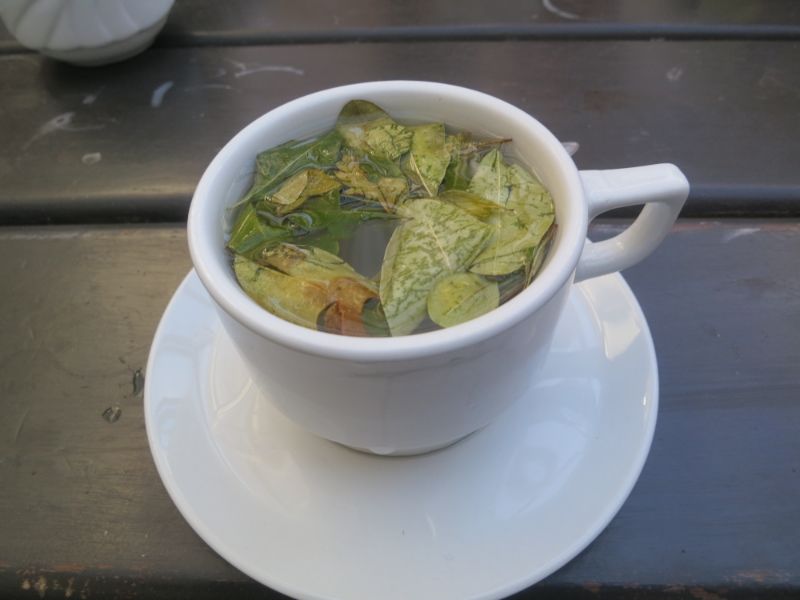
Cusco is located at 11,000 feet and mountains are visible all around its perimeter. It's common to spend a couple days in Cusco adjusting to the higher altitudes in preparation for hiking the Inca Trail. Some members of my group felt the ill effects of the altitude, but I managed to get off with mild tingling in my extremities. I credit my good fortune to a local remedy that was available all across the Sacred Valley: coca leaves. The moment I arrived at my hotel in Cusco, I was offered coca tea which is simply coca leaves brewed in hot water. The resulting liquid has a mild flavor that tastes like mint though quite mellow. It was also common to chew the leaves straight up (but don't swallow). They're not particularly pleasant to chew since they turn chalky and little bits get caught in your teeth, but if you chew enough of them your gums and tongue get numb and you forget your worries. I quite enjoyed the ritual of drinking and chewing coca leaves to combat the altitude.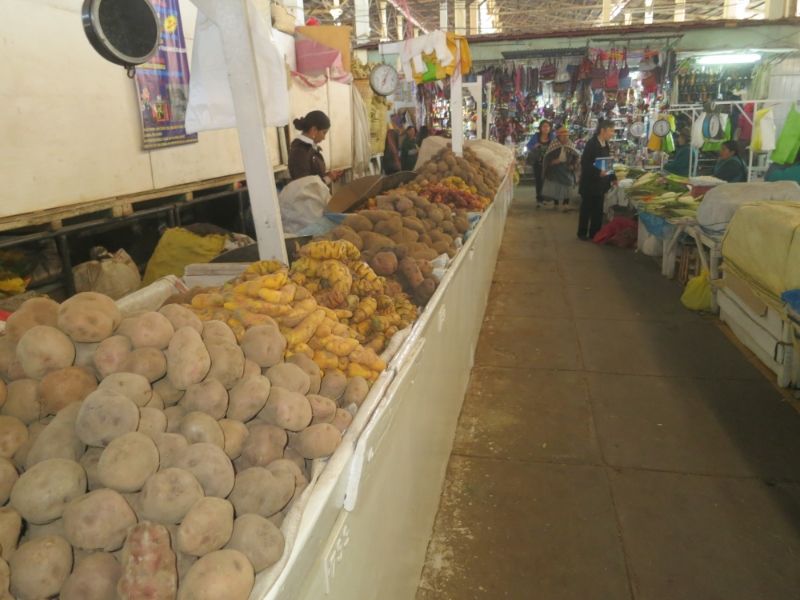
Unfortunately my experiences at Cusco restaurants weren't very good. The city is overrun with tourists and, as the woman who owns the hotel I stayed at explained, locals don't really go out for dinner. So there wasn't much in the way of local spots to grab a traditional Andean dinner. Fortunately, the San Pedro market, which is located a 5 minute walk from the main plaza in town, is decidedly local and doesn't really cater to tourists. Cusco is the regional capital and people come from all around to buy and sell their products. On Sunday in particular the market is bustling with locals doing their grocery shopping for the week.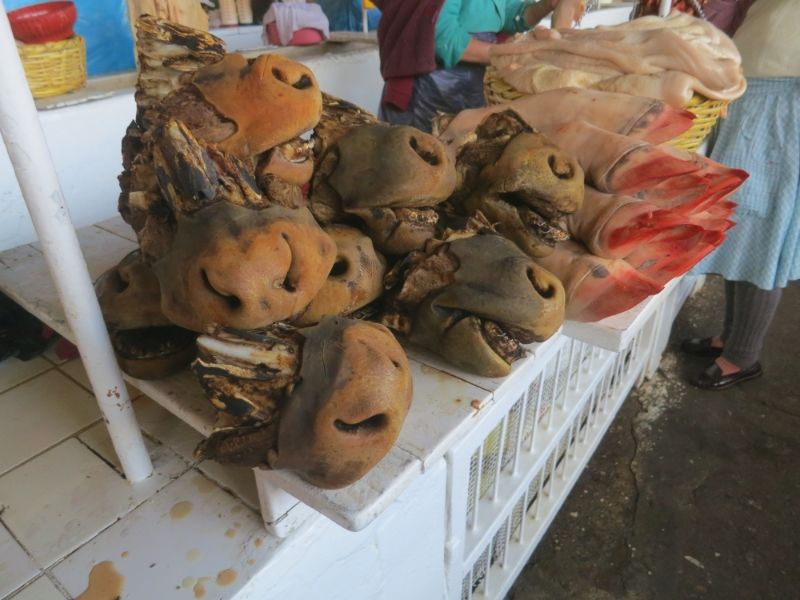
The market has just about anything you can imagine. Dozens of varieties of potatoes, unique fruits, and of course, snouts and other animal parts.
I honestly have no idea what this is used for.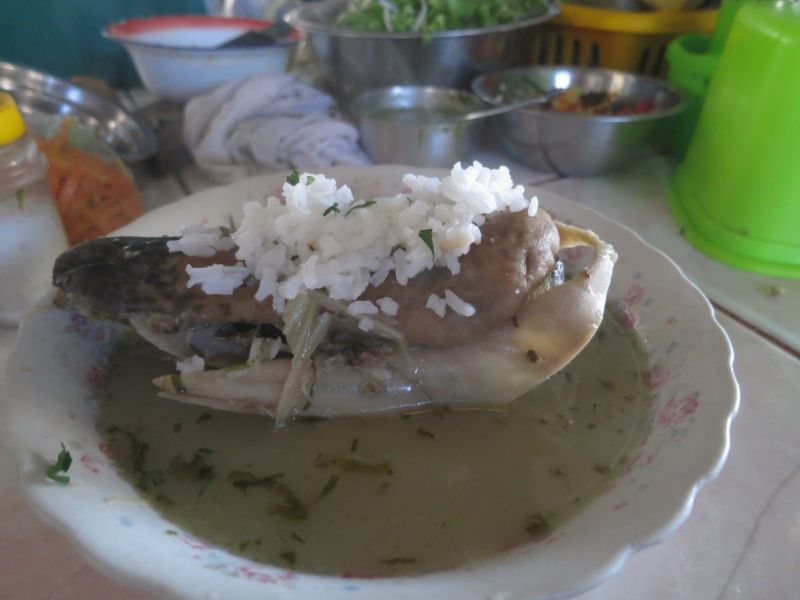
This is a sheep's head soup which is incredibly funky and not for the faint of heart. The soup is quite funky yet nourishing, and we impressed the hell out of the lady who served it to us. Not gringo fare by any stretch.
As any good Latin American market should, the San Pedro market has a wide variety of food stalls serving cheap and hearty local food. I was excited to try the aji de gallina, but it's a breakfast food that had run out the two days I made it to the market. I did get to try the lomo saltado though, which was probably the most common dish around town. It's stewed beef and potatoes with tomatoes and lots of onions. It was also common to order a side of fried trout. The food at the market was the best we had in Cusco.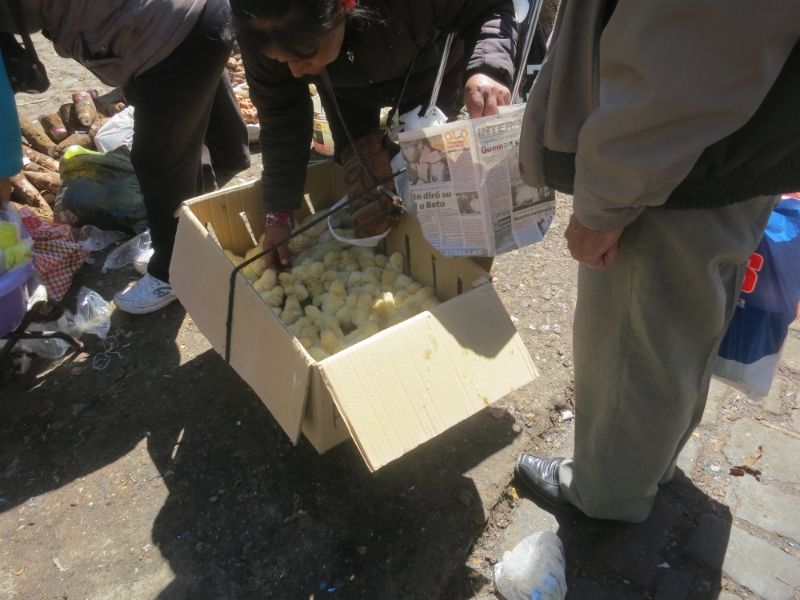
On Sunday, the area in front of the market has countless street vendors. This vendor was selling chicks, presumably to be raised at home, though I'm not sure.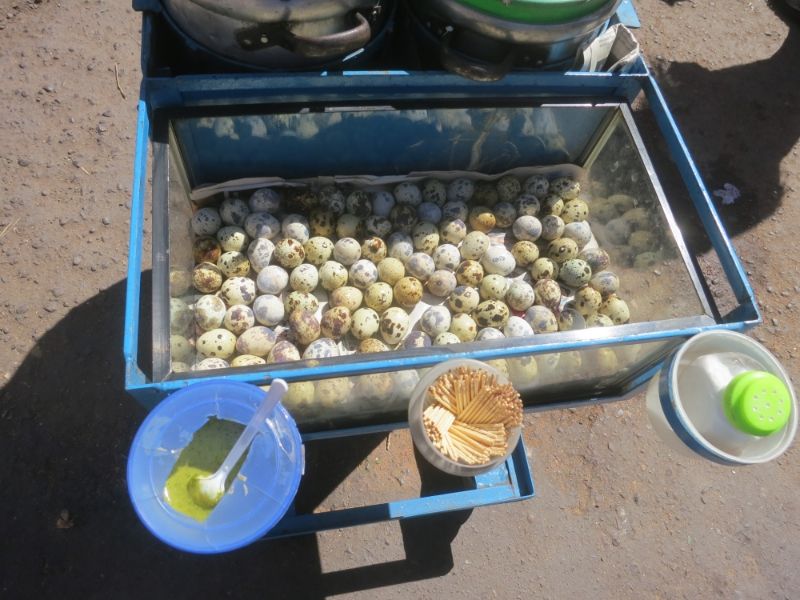
Hard boiled quail eggs with aji sauce. The eggs were sweet and nutty, a nice street treat.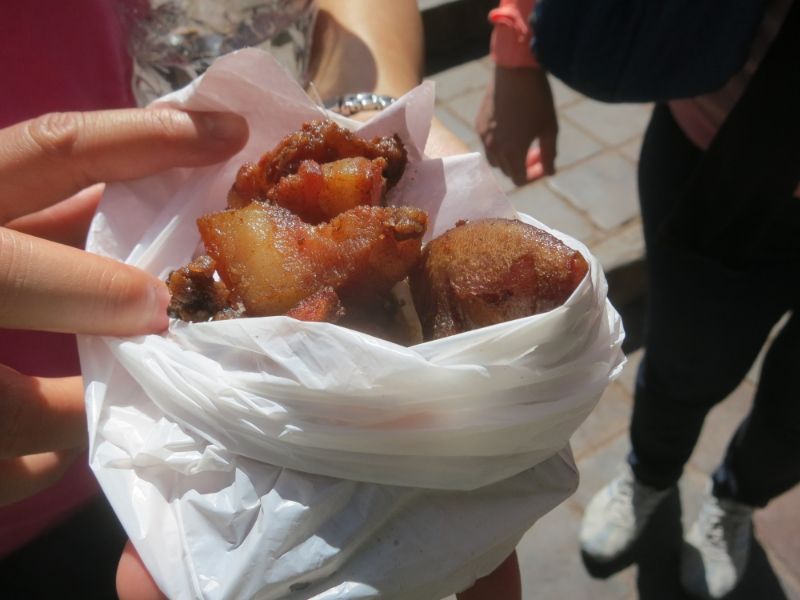
I love South American chicharones. The skin is crispy while the meat is fatty and chewy.
Crispy skin guinea pig, called cuy, was a popular item around Cusco. The guinea pig is quite fatty so it requires some care to get the flavor of the meat and not just a mouthful of cuy grease.
For dessert, dulce de leche churros.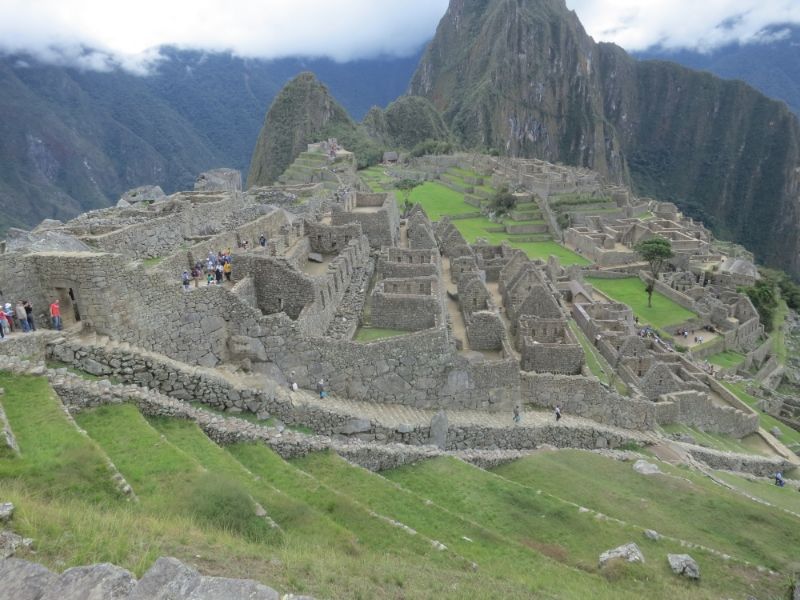
And of course, any trip to Cusco requires an obligatory stop at the world famous Machu Picchu.

